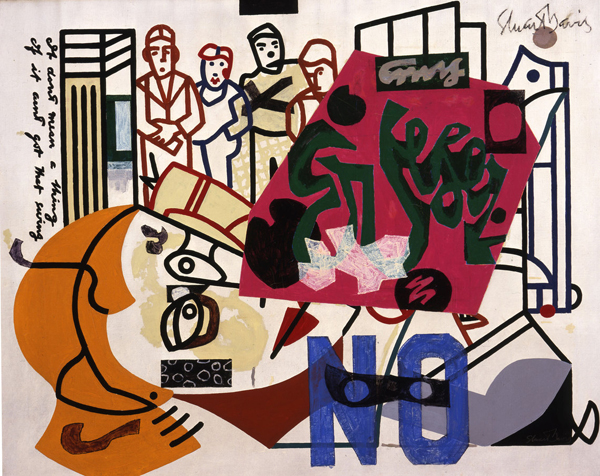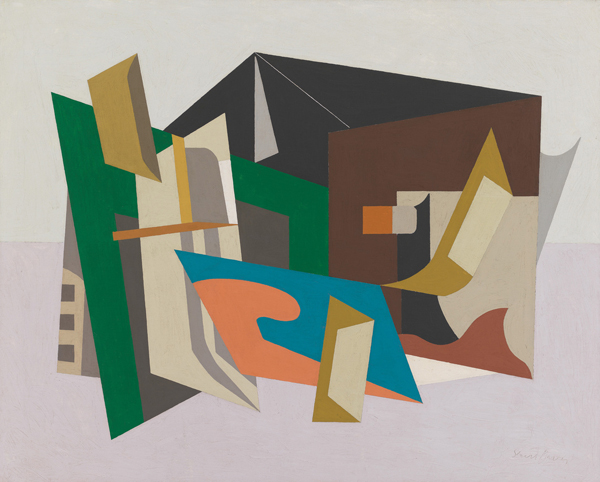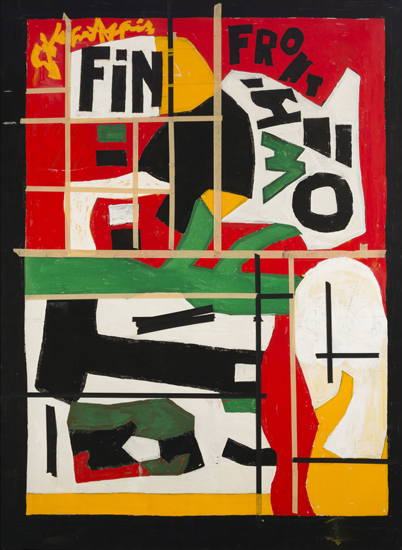Perpetual Ripplets: Stuart Davis
Yuko Otomo
October 2016
 American Painting, 1932 and 1942–54. Oil on canvas, 40 × 50 1/4 in. (101.6 × 127.7 cm).
American Painting, 1932 and 1942–54. Oil on canvas, 40 × 50 1/4 in. (101.6 × 127.7 cm).
Joslyn Art Museum, Omaha; on extended loan from the University of Nebraska at Omaha Collection.
© Estate of Stuart Davis / Licensed by VAGA, New York, NY
I saw 2 exhibitions of Stuart Davis in NYC with an almost 15 year time gap in between. My affinity for the artist has not changed over the years. In a sense, it has gotten deeper as I understand the what/how of the artist better. Part I is my reaction to the recent show of his work at the Whitney Museum this year and Part II is from the MET exhibition I saw in February 1992.
Part I
Stuart Davis: In Full Swing
@ The Whitney Museum, NYC
June 10 – September 25, 2016
In rereading the writing I had done for the 1992 Stuart Davis exhibition at the MET, I saw that I had expressed my affinity with the artist in regards to his psyche, passion & overall dedication to the art of painting. A sense of sincerity in his attitude toward the vocation impressed me immensely according to what I had written then. Now, I’ve seen a 2nd exhibition at The Whitney Museum. Here, again, I’ve witnessed his definite sense of awareness toward the destiny of being “a painter” in search of an evolution of the art of painting. Born out of a creatively privileged & progressive background, he stepped into the realm as if his destiny had been set before he was born.
Interestingly, this time I was more conscious of his painterly dynamism than I was 20 years ago. Then, I was more interested in his color/form/motif. For the first time at this exhibition, I was able to open my mind up to the “visual dynamism” he was searching for; how the reaction between the creative intention/efforts of the creator & the actual physical/metaphysical reaction of the viewer work “against” or “with” each other.
The zone shared by the creator & the viewer: “the final creator” in the Duchampian sense; how the dynamism between them gets enriched, shifted or lessened; how the visual impact caused by tones & intensity of colors can maneuver the effects; how & where of the viewer’s focal/focus points can affect the organic expansion of the dynamism presented by the work, etc. The most amazing new discovery for me was to have finally reached the realization of his multi-focus viewpoints that caused the expansion of the “frame” or the (rectangular) edges: 4 lines & 4 corners “materiality” of a painting. This discovery took place as I slowly walked through the show.
I started with works from the 1920s as exhibited. How very “Modern” these works look with their extreme visual simplicity & simplification of the content: form, color, tone & narrative subject. Coming from the social consciousness inherited from Robert Henri & the Ashcan school, he agonizes over which direction to take, between art’s autonomous-ness & the artist’s social (responsive) role. In the end, he chose to sabotage himself, to not be purely abstract, to not be totally devoid of visual symbols. Because of his determined sense of social responsibility in being an artist, he thought it was essential to have images that linked him (the artist) to the world that he lived in. He decided to stay with images. Flatness. Letters/signs. Motifs fit for Cubist Abstraction study. Egg Beater No. 1 (1927 oil on canvas); Egg Beater No. 2 (1928 o/c) Egg Beater No. 4 (1928 o/c)… I think of Man Ray’s Egg Beater Dada photo. The musicality of his color tonality; abstraction based on a sense of architectural distribution… they are remarkably alive, full of joyful energy as the late great pianist Connie Crothers called “Joy Energy,” a life-affirming physical, metaphysical life force emanating in every possible direction.
In the 1930s, his attention gets clearly focused on movement/non-movement; content (*he mediates on “what is ‘content’” & how to “fill-in”); line & plane. John Graham called his 1938 work Swing Landscape “the greatest American painting.” His relationship with Jazz is evident in both contextual & narrative contents. It is something to get such approval & praising comment from one of the most respected artistic thinkers of the time. As I go through this period of his work, I get more & more aware of how the space in his work expands & closes freely according to the reaction/movement of the tonality & the density of color-combination. This causes a phenomenon of a sort, affecting the mind of a viewer. He challenges on “edge:” the physicality of a “space container” of a work; a given material space: the definite “finite” condition a painting suffers, no matter what, whether it is painted on unusual & irregular shapes. In his work, it is as if multiple focal centers of a viewpoint exist at the same time. Plus/Minus & Push/Pull take place not just in depth but also with a width of the space to cause dynamism. Here, he relates to Jazz deeply because of the musicality & the physical dynamism it manifests.
Another thing he learned from Jazz was the organic principle of “non-hierarchical existence” of all parts/elements. Every part makes the balanced whole in space as in Mondrian’s Neo-Plasticism. In a way, his is a different type of “all over” painting. Familiar motifs continue repeatedly. On “recycling motifs,” he reacts, saying “it’s the same as when a musician takes a sequence of notes & makes many variations on them.” Non-hierarchical elements in his picture plane make even his signature* a part of the visual content of the work (* in a completely different way from Picasso’s famed usage of his signature in his work). Colonial Cubism (1954 o/c); Cliché (1955 o/c); Ready to Wear (1956 o/c); Medium Still Life (1956 o/c)… his work moves on. Strange fragmental words pop up in his space. “Any”; “Else”; “Any It”…& images of Black Cross… of Red Cross…
He further studies the physics of visual cognitions: how the visual stimulants that a viewer receives can influence his or her consciousness: Mind. Being involved with Jazz, he also learns how to create via intuition instead of rational & intentional calculations. A curatorial wall panel talks of “… the effect of a fast moving surface to push into the viewer’s space with enormous force…”. True, you feel the dynamism. In American Painting (1932-42-54 o/c), 3 names of the post WWII American Art giants: De Kooning; Gorky & John Graham are listed next to Ellington’s famed saying “It don’t mean a thing if you ain’t got that swing.” 1932 to 1942 to 1954. 22 years of time passing on one painting. He lived with this work for 22 years! American. Painting. What is “American”? What is “Painting?” What is “American Painting?” It is a riot! He says, “… help to keep eyes of the beholder alive… forces him to make observations and give value to aspects of nature where everyday preoccupations too often leave unnoticed… ” He is truly a physician of a visual dynamism.
As if he knew the moment was near, his last painting Fin (1964-62 o/c) sends his farewell to the world. He died on the way to the hospital. Like an actor who dies on the stage, he basically died in his studio. He was working till the end. Full of E’Spirit with an upside down signature of his name, this episode is as if it were a well-scripted French film. He knew how to swing. By the time he died, Pop-Art, a new genre that he unintentionally influenced in its development, was peaking to the height of popularity. I wonder how he was reacting to the new trend in art. How interesting it is to place his final painting Fin next to Mondrian’s last painting Victory Boogie Woogie! They are both unfinished with strips of tapes positioned here & there. Literally they were left Un-Finished as if the artists took a break or something in the middle of their jobs. How fascinating they both truly loved Jazz. Through their love for Jazz, they were learning about “Intuition” as the guiding spirit of creativity & “Non-Hierarchical Pictorial Elements” in space as their goals. Their shared sense of being a dedicated socially responsible artist propelled them to move on in search for the possible visual proofs of utopian non-hierarchical existence & life force in universal time/space.
Never pulled into the force of Abstract Expressionism that was intensely dominant in the time; unintentionally influencing Pop Art & never having been part of any particular art movement par se, Davis walked on his path in a grand solitude, swinging. Being aware of his linage rooted in Cubism, he studied further the role of intuition in the creative thought process & how visual dynamism worked. It is interesting to realize that Mondrian also comes from the cubist linage. What they wanted to know & learn through the music they fell in love with, Jazz, was how intuition worked in the creative thought process in order to make organically balanced, democratic & non-hierarchical visual elements in time/space. Like creative connections between music & painting cited by artists such as Klee & Kandinsky, 2 grand masters left us some “key” clues to deal with further. Sadly, Jazz is still an extremely marginalized art form in society even now. It is as if they are hanging in the air without being embraced, studied & investigated. What is “Intuition” & what does it mean to have “Non-Hierarchy Existence in Time/Space?” Now it is our turn to pay attention to their quests & the question.
 Egg Beater No. 1, 1927. Oil on linen, 29 3/16 × 36 3/16 in. (74.1 × 91.9 cm).
Egg Beater No. 1, 1927. Oil on linen, 29 3/16 × 36 3/16 in. (74.1 × 91.9 cm).
Whitney Museum of American Art, New York; gift of Gertrude Vanderbilt Whitney 31.169.
© Estate of Stuart Davis/Licensed by VAGA, New York
Part II
Stuart Davis, American Painter
@ The Metropolitan Museum, NYC
November 23, 1991 – February 16, 1992
I walked through this show for a limited time while I went to see the Seurat show at the museum a week ago with a firm intention to come back to see it again for real. Today we headed there with the dual purpose of listening to the Dewey Redman Quartet play in front of Davis’s work as well.
It is not easy to describe my sensible affinity to Stuart David in words. I know that our psyches overlap somewhere as if they were echoing with each other. Through examining his small works, I can well observe how much he loved “the art of painting” as his existential essence. I thought of taking detailed notes to keep of my reaction to each work, but something in me made an objection to doing so. I tried to figure out the “why” for this objection in the exhibition space, but I could not explain it to myself. But now back at home, as I move my pen, I’ve started to see the reasons clearly & easily. “Too easy to see” – “ Too easy to understand” – in other words, there are not too many things that I don’t understand there in his work. “Things that I can’t figure out” always invite my attention. When things are “easy to understand,” the intensity of my attention level usually gets less excited. But interestingly, this diminished excitement did not lessen my affinity & respect for Davis’ work. On the contrary, they expanded as I went further through the show. His sense of pureness & sincerity is totally something more than just being superb.
Early works done under the strong influences by Robert Henri & the Ashcan School; then, works under another massive influence, this time, by VVG; 1920s works created under the effects & experimentations of Cubism. It is so wonderful to see these early steps he’d taken as they set him into the right direction as a painter. Space=Air of Poetic-Humanism, which spread in his early American Realism works, show the quality of his gift on a grand scale. More than doing his own Van Goghesque work, he copies Van Gogh to learn where to place “passion” in his awareness rather than to learn some painterly skills for the mere purpose of practice. Van Gogh landscapes. Van Gogh self-portraits. The non-intentional sense of psychic pureness of the young Davis invites my smile. His Cubism Still Life is a superb work that can be set equal to works of Picasso & Braque. More than the Egg Beaters of the mid 1920s, Lemon & Glass of 1924 & the series in that spectrum initiated my strong attention. The 1921 Dadaistic Drawings, Untitled (2 pieces) are also beautiful.
The works done in 1930s Paris are not my favorites. Gertrude Stein’s rejections of Egg Beater pushed his art in some peculiar direction. His illustrative way of painting bleaches my curiosity. Yet, the “doodles” that popped up out of nowhere in these illustrative works are worth paying attentions to because of their purpose-less, meaning-less & intention-less quality of lively abstraction. Here we witness the unity of drawing & painting: an act of painting & drawing being one.
Back in US, in the 40s, he created works I do not care for too much either. Except for a few works, his attention goes more toward the narrative side of landscape. Yet, the tonality of colors is gradually but surely firming itself up in his world. Feeling a bit unsatisfied, I move to the next room. There, suddenly, I am embraced by the brilliant sense of existential weight of Colonial Cubism & the works following it. In the 1950s, the base foundation of Davis world is finally come to fruition. In many works, such as Ready to Wear, I see “flat-cubistic-abstraction” sing of simply complicated, complicatedly simple pictorial structural elements in space. In this period, his sensitivity for color-tones solidifies its own world. The works from 1959 are my favorites (*of course, along with my romantic affinity leaning toward his very early works). Each work is filled with a solid strength that has conquered itself after going through many ups & downs of trials & errors. It’s a shame that I didn’t take notes on each work.
In the 1960s, the extension of the 50s’ work & style moves on. Yet, the certain sense of intensity does not breathe as much it used to in the 50s works. Letter and his Ecol (Black & White Version) is beautiful. It makes me think of something, but I cannot grasp that something, maybe the Blue & White painting by late Klee, I let myself guess. His final unfinished work of 1964 Fin looks “left behind” as if the artist took a break, taking a walk or something, in the middle of the job. Some amazingly carefree sense of vitality emanates all over it to make one imagine that the artist might as well come back to finish it. It’s fascinating to see “Complete” & “Fin” show up many times in many of the very late works leading up to the final work as if he was clearly aware of his own death & its approaching moment.
“(An) autonomous sensate object(s)” – I was happily moved to see the notion. This is exactly what I mean when I talk of “the autonomy of an organic pictorial contents/structures” created by, of & for “the self-existence of color; form; line & touch”. Throughout the history of the art of painting, there are not so many artists who had been aware of this philosophical background. Instead of paying attention to the base historical assessment of Davis being the father of Pop Art, we should pay serious attention to the fact that he was one of the rare artists who was clearly awakened to the philosophical elements of “autonomous sensate objects.” This awareness brings in the aesthetic quality to Abstract Art to deepen its meaning & to focus on its direction.
PS:
Davis’ love for Jazz made him name his son Earl (after Earl Hines). Dewey Redman’s Quartet played in front of Davis’ work from different periods for three 20 minutes sets every hour from 6 PM to 8 PM. This live concert was programmed to give respect back to Davis’ devotion to & love for Jazz. In between the sets, we saw a film Davis on NBC: Earl Hines & Coleman Hawkins on the ground floor.
 Fin, 1962–64. Casein and masking tape on canvas, 53 7/8 × 39 3/4 in. (136.8 × 101 cm).
Fin, 1962–64. Casein and masking tape on canvas, 53 7/8 × 39 3/4 in. (136.8 × 101 cm).
Private collection. © Estate of Stuart Davis/Licensed by VAGA, New York
